|
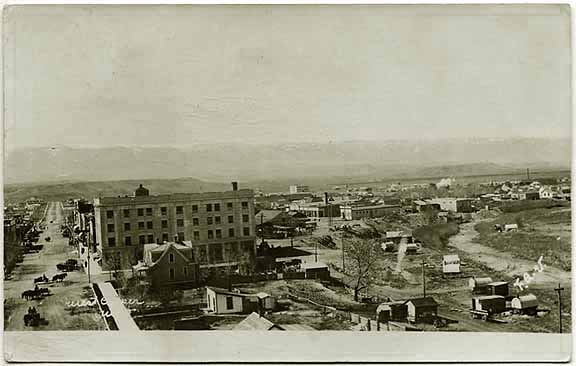
Casper, undated, looking toward the Mid-West Hotel.
To the west of the hotel is the Midwest addition to Casper. On the lower right-hand side of the photo may be seen a portion of the stream which was filled in to form the
Sand Bar District of Casper, discussed on the next page. Note the sheep wagons parked on the area below the slope.
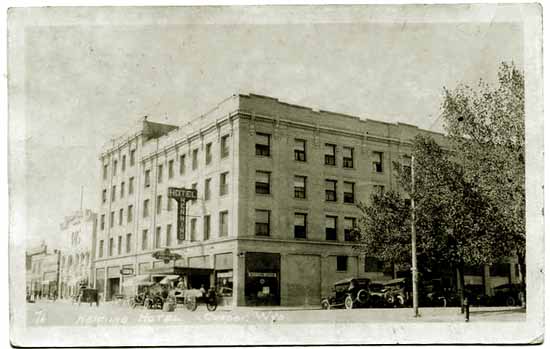
Hotel Henning, Southwest corner of Center and First, approx. 1921.
In the twenty year period from 1910, Natrona County grew from a population of
4,766 to 24,272 in 1930 before it leveled off during the Great Depression. The result as indicated in the following photos was
a transformation of center Street from a dirt thoroughfare lined with false-fronted stores and
saloons, to a street dominated by grand hotels and motion picture palaces. And one of the first of the
grand hotels was the Hotel Henning, the north portion of which was formerly the Midwest Hotel. The Midwest Hotel opened
1914 under the managment of Frank J. Donohoe who managed a number of other hotels. Plans for an extension on the south side of the
hotel were made. The extension
was to be called the Midwest Annex. Unfortunately, in 1915, the sheriff executed a levy on the furniture in the hotel. This resulted in
local businessmen forming a new corporation to acquire, refurnish the hotel and complete the extension. "Promotion stock" was issued as well as bonds
to pay for the hotel. "Promotion stock" are shares that are sold, but the proceeds to not go into the
corporation, but instead into the pockets of the promoters. Thus, the hotel was paid for with the proceeds of the bonds. The promotion stock
was essentially of little value. One of the promotoers, a plumbing contractor Welker F. "Happy" Henning, was able to acquire the stock in the hotel at
from the remaining promoters for pennies on the dollar. Henning had made substantial money in the installation of water mains using
trenching machinery. Other bidders on the project were still using hand labor and wagons. With the aquisition of the
Hotel, Henning became Casper's first millionaire. Henning renamed the hotel after himself. For his wife Lucie, he constructed a mansion on South Wolcott street. The house is still in
existence. Additionally, in the late 1920's Henning owned a weekly newspaper, The Casper Independent which he sold in 1931.
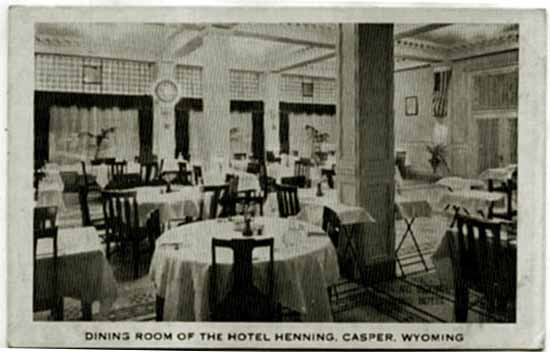
Dining Room, Hotel Henning, 1928.
As discussed with regard to Oil Camps, the
oil boom hit Wyoming about 1916 with the development of the Salt Creek, Midwest, and Big Muddy Oil Fields. The center
of this boom was Casper; and in Casper the Hotel Henning was the center. Professor Larson observed that most of the trading of
oil stocks was done in the lobby of the Hotel Henning and customers "flowed into the streets on many evenings." Lason, p. 406.
Casper historian A. J. Mokler recalled,
"Men in all walks of life neglected their business and their professions to buy and sell oil
stocks." Leslie A. Miller, President of the Chief Oil Company, and later governor, testified before
the House of Representatives that there was a "whole herd" of promotors, who for the greater part
"do very little drilling. Once in a while to protect themselves from the Post Office Department they do a little
drilling, but their chief aim is to sell stock."
Alfred James Mokler was the publisher of the Natrona County Tribune, an ancestor of the
present day Casper Star-Tribune; editor of the short-lived Wyoming Pioneer, a bimonthly
historical journal; author of History of Natrona County, 1888-1922; Grand Historian of the
Wyoming Masonic Grand Lodge; and served two terms as Master of Casper Lodge No. 15.
The Casper Daily Tribune every day devoted one whole page just to the oil trading and the news of new wells being drilled, etc.
Additionally, a large portion of the front page was devoted to national news and business and Casper's business was oil. In contrast, its competitor the
Casper Herald generally devoted a major portion of its front page to murders and the national scandals of the day. Compare the headlines from the
two papers for the same day, November 27, 1922:
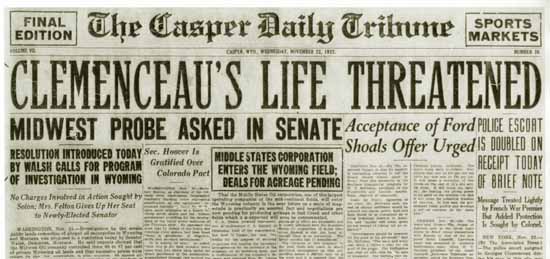
Headlines Casper Tribune, Nov. 27, 1922
The Midwest Probe represented the beginning of congressional investigations into the Midwest
Refining Company and its president Henry Myron Blackmer. In 1923, Blackmer fled to France rather than answer subpoenas concerning his
involvement with the Teapot Dome Scandal.
The French Government refused to extradite him back to the United States. The United States government then revoked his passport so that
he was confined in his travels to France. In Paris, he resided on Rue de Pesbourg off the Etoile a short distance from
the Travellers Club where he was the club "trictrac" champion. On clear days he would play golf. During World War II, he
managed to flee to Switzerland. In 1947 Blackmer returned to France and in 1949 made a deal with the
federal government enabling him to return to the United States.
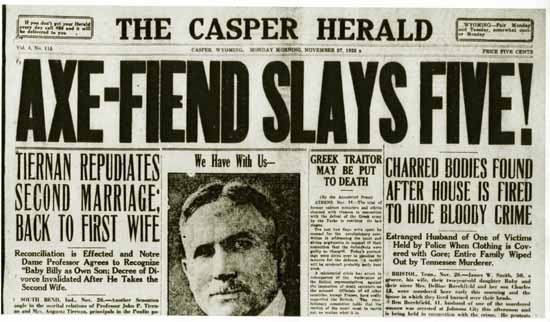
Headlines Casper Herald, Nov. 27, 1922
To reassure the reader, Senator Kendrick whose picture is under the headline was not the axe murderer. The axe fiend was in Tennessee. Tiernan was a
Notre Dame professor who was an alleged bigamist. The headlines were not aberations.
The headlines from the Herald for the five preceeding days:
November 22: "SLAYING ROUSES TEXAS MOB;" POISON SLAUGHER OF SIX MAY BE REVENGE
NovembeR 23: "MINE BLAST KILLS 100!" POISON SLAUGHER OF SIX MAY BE REVENGE
November 24: "GUNMEN GET SWIFT JUSTICE!"
November 25: "REVEALS MOTHER'S MURDER! BODY FOUND IN TRUNK FOUND WHEN POLICE HELPS CHILD"
November 26: "CRUSH 'BABY-CASE' ROMANCE"
The latter headline related to Professor Tiernan's marital adventures.
Most of the speculative companies went belly-up. Most of the
oil in the principal fields was controlled by the major operators, Standard of
Indiana (now BP), the Midwest Oil Company (merged in 1920 with Standard), Ohio (now Marathon), and
Sinclair
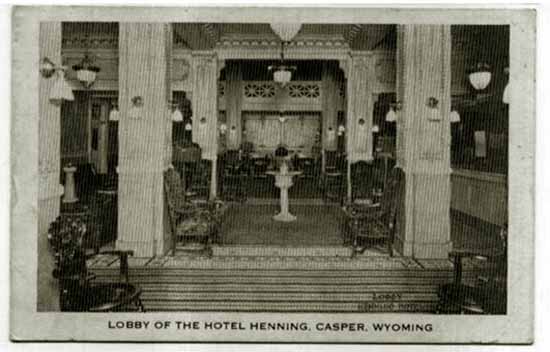
Lobby of the Hotel Henning, 1928.
The editor of the Bolivar, New York, Breeze wrote of his visits to Casper, reprinted in the Petroleum Gazette,
September 1917, p. 4:
My first visit to Casper was in July of last year. Since that time it seems to me Casper has
practically doubled in population—and it is still growing rapidly. I am told the population
now exceeds 9,000. Hundreds of bungalows and many fine residences have been erected during the
past year. A new hotel, the Henning, was opened the other day and guests were being turned away
the third night. The Mid-West. Casper's first large hotel, is overflowing and tonight there are
a number of cots in the writing room floor. Every room is filled and some of the rooms contain
two or three guests. A four-room log house out on Ash street is renting for $30 a month.
An ordinary eight-room house brings $60 a month. A new three-story apartment house now under way
is all rented. A four-room apartment brings $60 a month. An Olean man who has been here for
four months is still house hunting. One woman who has been here sixteen months has moved
fourteen times. In each instance the house she was renting was sold and it was her move. A
grocer told me that in making delivery he found that 22 persons were living in two adjoining
eight-room houses, three families, an average of 11 persons for each house. At the postoffice
the general delivery line is a long one. It is the same way at the railroad stations. The Western Union Telegraph office employs seven persons and is open until 2 o'clock in the morning. Soon the service will be day and night. The twelve saloons of Casper are closed only from midnight on Saturday to midnight on Sunday. The license fee is $1,800 and beer 15 cents a glass. A shoe shine is 15 cents and a shave 25 cents. Living expenses are 20 per cent, or more higher than in a city of this size in the east. Tbe altitude is high and everything else follows suit but nobody complains because money is plentiful and Wyoming prosperous.
The deposits of the five banks of Casper are in round numbers about five million dollars. One
Wyoming rancher sold his wool clip this season for $320,000. A six-story office building is
going up on the main business street and other substantial business blocks are under way. The
streets are crowded at night and there are more automobiles parked along the business streets
of Casper than you will see along Union street in Olean, a citv twice the size of Casper.
Casper has half a dozen brokerage houses dealing in Wyoming oil stocks. At least three new
million-dollar oil companies are launched each week and the Casper citizen who hasn't a hat
full of certificates of oil stock under his pillow can't sleep at night. There has been a lot
of easy money made in the oil stock game by promoters and locators. One man came here four
months ago with just his car fare, opened a brokerage business and has cleaned up $12,000 in
the game, so a friend of his told me. Some of the oil companies have leases of value, but many
of them are rank prospects. If every oil company advertising to have proven acreage inside the
Salt Creek dome, really had it, the Salt Creek dome instead of covering about 6,000 acres would
have to embrace all of Natrona county. Casper has two live dailynewspapers and they reflect the
enterprise, spirit an growth of the little city.
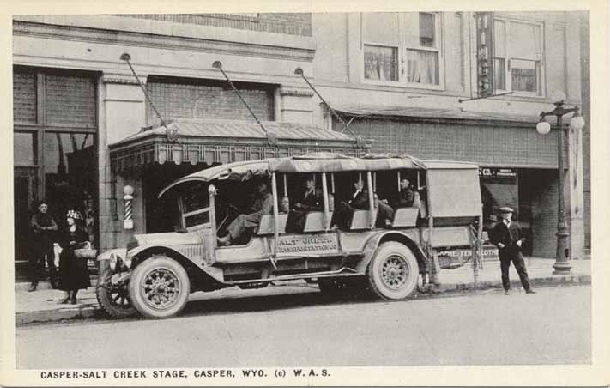
Casper-Salt Creek Stage about to depart from in front of Hotel Henning, approx. 1920.
The Hotel Henning was the center of transportaion to Salt Creek. In addition to the motor stage,
Simon Apgar had a taxi stand at the hotel which provided rides to Salt Creek in his Studebaker for $3.00 a person.
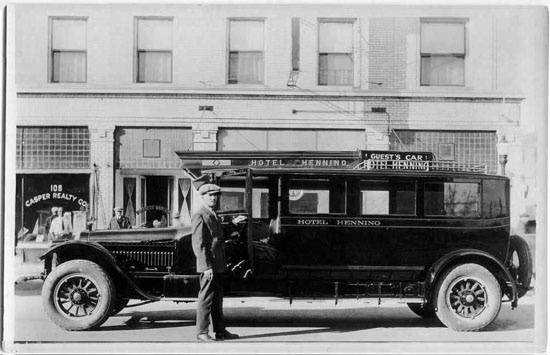
Hotel Henning courtesy car, approx. 1920.
Following World War I, Robert B. "Bob" David (1894-1968) returned to Casper to work for Standard Oil which at the time operated the
world's largest refinery down on the Platte River west of the Bridge. His father, Edward T. David, had worked as forman of Carey and Brother's CY. David Street was named
for the elder David. He recalled that upon his return "homes were often erected on high foundations, in order that the
basement rooms could be rented to obtain the high rentals that were being charged everywhere." See David, Robert B. typewritten
manuscript of his memoirs, Casper College western History Center, p. 1351. As discussed on the next page, the Sandbar was in full
flower.
W. F. Henning, himself, had a reputation for being a bit difficult to work with. In one instance, he
had the hotel's auditor arrested for allegedly stealing a night's receipts. After the charges were
dismissed, she successfully sued, the jury finding upon disputed evidence that "some time during the year 1928
the defendant [Henning] made threats against the plaintiff that he would get even with her because she refused to give false
testimony at defendant's request in a divorce action then pending between defendant and his wife." See
Henning v. Miller, 44 Wyo 114, 8 P. 2d 825 (1932). In another action, a real estate broker managed to get Henning's
signature on a contract to sell the hotel. In an appeal, the Supreme Court noted testimony that
"any man that could deal with Mr. Henning should be congratulated as Mr. Henning was one of the hardest men
in Casper to do business with." Desmond v. Poulos, 69 Wyo. 129, 237 P. 2d 853 (1951). Two actions involving the City of
Casper wended their way to the Wyoming Supreme Court. Indeed, it almost seemed as if he were a one-man lawyer's relief. In the late 1930's, he was involved in various
lawsuits against county commissioners as well as various appeals in other actions. See also
Henning v. City of Casper, 63 Wyo. 352, 182 P 2d 840 (1947); Henning v. City of Casper, 50 Wyo. 1, 57 P 2d 1264 (1936); First National Bank of Denver v. Hennng, 150 P. 2d 790
(Colo. 1944).
The Henning when it was built dominated the skyline of Center Street. It was soon overshadowed, however, by the Gladstone. The Gladstone was
seven floors and boasted a height of 80 feet while the Henning was not quite 60 feet in height.
Henning put a giant electically illuminated sign on the roof of the hotel.
Thus the hotel again dominated the skyline of Casper. Indeed, Lynne Cheney made note of it in her memoir
of Casper. To some the sign made the hotel seem as tall as a giant skyscraper in a big city. Lynne Cheney referred to one baton twirler on roller skates
as able to toss his batons "higher even than the Henning Hotel." Cheney,
"Blue Skies, No Fences: A memoir of Childhood and Family," p. 125 The Henning regularly hosted major state meetings, including the Republican Prty, the
Wyoming Fair and Rodeo Association as well local civi clubs and wedding receptions. It hosted the reception when Lynne and Dick Cheney were married in 1964. But even then the hotel was on its
last legs. As discussed on a subsequent page, the Gladstone constructed a new even taller addition topped by its "Sky Room" dining room and night club.
Following W. F. Henning's death, the hotel was auctioned off in 1949. It thereafter operated under different owners. Shortly after the Cheneys were married, the hotel was
the hotel went through the ignominy of foreclosure and was torn down to make way for a parking lot.
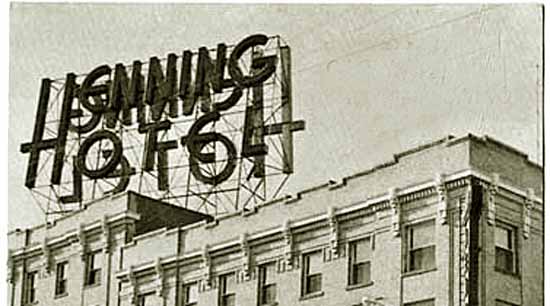
Sign on roof of the Hotel Henning, approx. 1952.
One small part of the hotel remains alive. The bar from the hotel's Elbow Room Lounge found a new home in a VFW Post in Edgerton. From there it
found its way to a lounge at Lake DeSmet north of Buffalo.
Other principal hotels were the Townsend, The Gladstone, and the Wyatt depicted on a subsequent page. Movie Palaces
included the Iris later the Rex, the Rialto, and the art deco America theatres. In addition to the boom on Center Street, another
boom occurred as a result of the gushers of oil in the nearby fields. At west end of First Street originally was a small
stream which had silted in and formed an island which became known as the "Sand Bar." As depicted in the photo at the top of the page, the island was used to
park sheepwagons. Following the construction of a
spur track to serve the refinery and the wool warehouses, the area was filled in. The area to the northwest of First Street and David Street continued to
to be called the Sandbar. As discussed on the next page, a different type of boom fueled by railroad workers and oil riggers arose on the Sandbar.
Next page: Casper continued, the Sandbar.
|